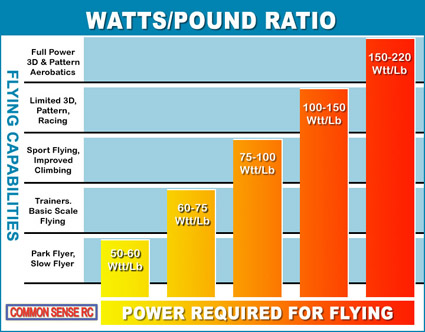 |
Flying High With Electric Power!
The Ampeer ON-LINE!
Fly the Future - Fly Electric! |
Site Table of Contents
| President: | Vice-President: | Secretary/Treasurer: |
| Ken Myers | Richard Utkan | Rick Sawicki |
| 1911 Bradshaw Ct. | 240 Cabinet | 5089 Ledgewood Ct. W. |
| Commerce Twp., MI 48390 | Milford, MI 48381 | Commerce Twp., MI 48382 |
| (248) 669-8124 | (248) 685-1705 | 248.685.7056 |
 | ||
| Board of Directors: | Board of Directors: | Ampeer Editor |
| David Stacer | Arthur Deane | Ken Myers |
| 16575 Brookland Blvd. | 21690 Bedford Dr. | 1911 Bradshaw Ct. |
| Northville, MI 48167 | Northville, MI 48167 | Commerce Twp., MI 48390 |
| 248.924.2324 | 248.348.2058 | 248.669.8124 |
| Mailed Ampeer printed subscriptions are no longer available.
The Ampeer is FREE on-line in Acrobat .pdf format and HTML with active links! | ||
| The Next Flying Meeting:
Date: Saturday, Oct. 4 Time: 10 a.m. Place: Midwest RC Society 7 Mi. Rd. Flying Field | ||
| What's In This Issue? | ||||
| Upcoming AMA District 7 Town Hall Meeting Meeting Announcement | Making Sense of Brushless Outrunner Names and Nomenclature Ken Myers describes brushless outrunner nomenclature and explains why a motor's name does not always indicate its glow equivalent power. | |||
| March 2014 EFO Meeting Details and photos from the March EFO meeting. | April 2014 EFO Meeting, Details of the April EFO meeting. | |||
| May 2014 EFO Meeting Details and photos from the March EFO meeting. | ||||
|
From Joe Hass Sunday, October 26, 2014
Ultimate Soccer Arenas
FEATURING AMA DISTRICT 7 VP
FREE INDOOR FLYING
HEADQUARTERS GUEST SPEAKERS PROGRAMS AND SURPRISES Making Sense of Brushless Outrunner Names and Nomenclature
On August 28, 2014, I gave a presentation to the Toledo Weak Signals on this topic. I prepared a handout, which is presented here in blue font. I have added comments and/or corrections in default Website font, the font usually used in The Ampeer on the Web. 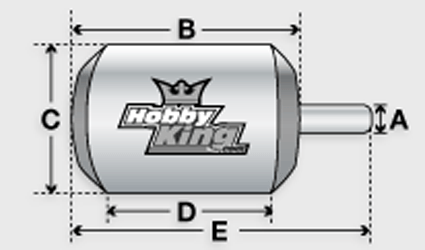
Outrunner Dimension Diagram from Hobby King Explanation of Hobby King's nomenclature: Turnigy - brand-name used by Hobby King
After further consideration and research, I believe that G46 is meant to mean a glow 0.46 cu.in. equivalent. The table below shows a comparison using two different O.S. 0.46 glow engines. The source for the 46 LA is the July 2010 issue of FlyRC. The source for the 46 XF info is here.  The props are APC sport types. The fuel used in both engines contained 15% nitro methane. The prop power, power out (Pout), was obtained using Drive Calculator's prop factors and exponents. The required watts in (Pin), at the given efficiency of 80%, shows the watts in required by an electric motor to produce the equivalent Pout at the prop. The table demonstrates that NOT all glow 46-size motors were created equal. Using the nomenclature G46 for a glow equivalent really indicates nothing useful about the actual power, except that it could be used in an airframe conversion that suggested that size glow engine. Continuing the handout: Diameter in mm is C in diagram

Hobby King's Three G46 Motors Note the differences are in the Kv and oddly in the pricing of the Turnigy. Generically I call the various Turnigy G46s
Cobra - brand-name used by Innov8tive Designs
 Generically I call the various Cobra 4120s
The similarity between the two motors is hopefully obvious. HK notes 55 amps for all three Kv versions of the G46. Innov8tive notes 45 amps for the 22-turn and 75 amps for the 12-turn. A higher number of turns requires smaller diameter wire and visa versa. Smaller diameter wire has a higher resistance than a larger diameter wire and handles less current than a larger diameter wire. Hobby King does NOT note the turns nor the termination. Both are involved in determining the Kv. The various Kv numbers of the Hobby King motors indicate a different number of winds and therefore the maximum continuous amps should be different with the 670Kv being higher amp capable than the 420Kv motor. For similar weight motors running on the same number of cells (voltage), the lower the Kv the larger the prop it can turn safely in its amp range and visa versa.
Innov8tive Designs, Lucien Miller, has posted real world prop charts for ALL of the Cobra motors. |
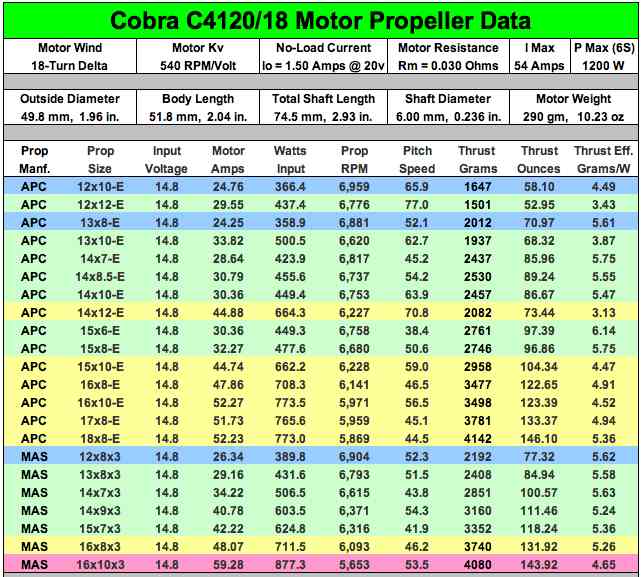
Typical Innov8tive Designs Propeller Data
|
The data in the following tables comes from those prop charts.
The input voltage for the chart below is 14.8v. That's equivalent to a 4S LiPo.
The amps were chosen using the 80% rule
 When the voltage (more cells) on the same motor increases, the props become 'smaller' to keep the amps in the safe, usable range.  For the table above, the voltage used was 18.5v. That's equivalent to a 5S LiPo. The motor and cell count to choose depends on the mission, type of airframe, the propeller clearance and the weight of the airframe. 80% Rule of Thumb To keep all parts of the power system happy, use the 80% Rule of Thumb. Try to keep the maximum amp draw for a motor and electronic speed control (ESC) to 80% of the maximum rating.
Use only 80% of a LiPo's capacity.
A timer is essential. A transmitter timer initiated by, and stopped by, the throttle on the transmitter is perfect. Be careful Many suppliers are not helpful in selecting props. Horizon Hobby has an E-flite Power 46 670Kv outrunner.
It is similar to the previous motors. From the Horizon Hobby Website:
That is incorrect! The motor is rated for 55 amps. Using a 12x8E with a 5S LiPo on this weight and Kv motor typically draws about 50 amps. (Reference: Drive Calculator) A 14x10E with a 5S pack typically draws about 100 amps. A 14x10 with a 4S LiPo typically draws about 70 amps, which is still too much.
It is NOT a range!!! To know what is really going on with the power system, a power meter, AKA watt meter, is an essential tool. To learn more about the Basics of Electrically Powered flight, visit The Ampeer Website. A link to "Electric Power Basics" is on the homepage. Explore the EFO site for many more articles and reviews of electrically powered planes and power systems. The Complete Ampeer Index, found in the site table of contents, goes back to the first issue of the The Ampeer, February, 1988. Levels for Various Types of Aircraft
The Common Sense RC's table suggests power levels based on Watts (watts in) per pound for ready to fly aircraft weight. It is a reasonable guide. 1.) Start out slowly and take the time to learn what you need to know
1.) Store Li-Poly batteries safely and away from combustibles.
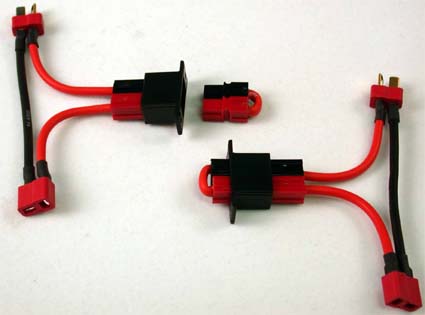 7.) Make or break arming switches, like those sold by Maxx Products International, LLC., are an excellent type of safety "switch", especially for large scale aircraft. Is a generic 5055-670Kv, 300g outrunner a 0.46 glow equivalent? Well, yes and no. The O.S. 0.46 LA/XF table indicates that an APC 10x7 sport prop needs to turn between 11,800 RPM and 13,000 RPM to be equivalent to a '0.46' 2-stroke glow engine. Drive Calculator indicates that the AXI 4120/14 can turn an APC 10x7 sport prop at 13,399 RPM using 22.2V (6S LiPo), drawing 41 amps for about 910 watts in. As previously mentioned, Lucien Miller is known for providing the best motor, voltage and prop data in the business. I value his dedication and hard work in this area. How he collects this data is explained on RC Groups. The prop chart for the Scorpion SII-4020-630 shows an APC 10x7E prop turning 12,966 RPM using 22.2V (6S LiPo), drawing 45 amps for about 1000 watts in. Those numbers indicate that a 5055-670Kv, 300g motor can be a 0.46 2-stroke equivalent when a 6S LiPo pack is used. Great Planes ElectriFly RimFire .60
AXI Gold 4120/14 Outrunner Motor
Scorpion SII-4020-630
Both Great Planes and Hobby Express note a 5055-670Kv, 300g motor as a 0.60 2-stroke equivalent. A review of the O.S. 65 AX glow 2-stroke shows an APC 12x7 sport turning 11,525 RPM and an APC 12x8 sport turning 10,550. Drive Calculator indicates that the AXI 4120/14 can turn an APC 12x8 sport prop at 10,412 RPM using 18.5V (5S LiPo), drawing 62 amps for about 1140 watts in. The prop chart for the Scorpion SII-4020-630 shows an APC 12x8E prop turning 10,250 RPM using 18.5V (5S LiPo), drawing 59 amps for about 1100 watts in. Those numbers indicate that a 5055-670Kv, 300g motor can be a 0.60 2-stroke equivalent when a 5S LiPo pack is used with a higher amp draw. Therefore, a 5055-670Kv, 300g motor can ALSO be a 0.60 2-stroke equivalent. Hobby King has two other Turnigy G46 motors. They are similar to two of the Cobra motors that Lucien Miller has provided prop data for. The similar motors are:
The Propeller Data Chart for the C-4120/22 shows an APC 12x8E, turning 10,443 RPM, at 38.3 amps with 29.6v (8 LiPo cells) applied for 1132 watts in. That's a 0.60 2-stroke glow equivalent RPM. That is the only 0.46 or 0.60 RPM 'match' for the 430Kv motor. Therefore the Turnigy G46 420Kv motor, with a 5055 size really could be labeled a G60 if 8 LiPo cells are used with a 12x8 prop. The Propeller Data Chart for the C-4120/18 540Kv shows an APC 10x7E, turning 13,557 RPM, at 39.9 amps with 29.6v (8 LiPo cells) applied for 1182 watts in. That's a little more RPM than a 0.46 2-stroke glow. That is the only 0.46 or 0.60 RPM 'match' for the 540Kv motor. Therefore the Turnigy G46 550Kv motor, with a 5055 size, can be labeled a G46 if 8 LiPo cells are used with a 10x7 prop. The Cobra line also has a 610Kv, 710Kv and 850Kv. The 610Kv can turn an APC 12x8E at 10,837 RPM at 60.4 amps using 22.2v (6 cell LiPo). That is similar to a .60 2-stroke. The 710Kv can turn an APC 10x7E at 13,083 RPM at 47 amps using 22.2v (6 cell LiPo) for 1045.3 watts in. That is similar to a .46 2-stroke. Also, the 710Kv can turn an APC 12x8E at 10,385 RPM at 63 amps using 18.5v (5 cell LiPo) for 10,385 watts in. That is similar to a .46 2-stroke. The 850Kv can turn an APC 10x7E at 12,979 RPM at 56.5 amps using 18.5v (5 cell LiPo). That is similar to a .46 2-stroke. This is a HUGE amount of information to take in and understand. A 5055-xxx, 300g motor can be equivalent to a 0.46 2-stroke or 0.60 2-stroke when using a certain Kv with a specific number of cells and a specific prop diameter and pitch. Just giving the motor itself a name that seems to relate to a 2-stroke displacement, does NOT make it equivalent in most instances where it will be used. There is a Rimfire 50-55-500 with a weight of 290g. Drive Calculator calculates that a similar motor at 25.9V (7-cell LiPo) turns an APC 12x8 sport prop at 10,489 RPM while pulling 45 amps for 1158 watts in. That's equivalent to a 0.60 2-stroke. Check the link to see what Great Planes considers their motor equivalent to. There is another kind of glow engine, the 4-stroke. A Saito 62 could swing an APC 12x8 sport prop at 9,600 RPM. Using the factor and exponent from Drive Calculator for an APC 12x8 sport prop estimates 718 watts out, Pout. Using 80% efficiency, that would be 898 watts in. That is roughly the same power as a 0.46 2-stroke, 900 watts in to 1000 watts in. Bob Boucher, Mr. Astro Flight, began the naming of electric motors with an equivalent glow terminology so that people unfamiliar with electric motors would know what size airframe to put his motors in. Many suppliers still use Bob's idea. More often than not the 300g outrunner with various Kv numbers and cell counts is not used as a true equivalent power system for a glow .46 2-stroke or .60 2-stroke. It is used, as Bob envisioned, as a reference for what size plane the motor is useful in. One advantage of an electric power system is that it can swing a larger diameter prop with more pitch, providing more 'power' than some might expect. Recently, I've been involved in helping a couple of flying buddies with conversions of their Sig 4-Star 40s. One buddy purchased a Turnigy G46 670Kv motor. It is running on a 6S "A123" 2500mAh pack. It is turning an APC 11x7E prop at about 10,300 RPM while pulling approximately 35 amps for about 600 watts in. The pitch speed is approximately 68 mph. At 600 watts in, it is about 300 watts in shy of a .46 2-stroke equivalent, but still flies the Sig 4-Star 40 just fine. The other flying buddy is just building and setting up his Sig 4-Star 40. He chose to use a 6S "A123" 2500mAh pack as well. I recommended the Cobra C4120/18 540Kv motor with an APC 13x10E. I reported on this power system in the January 2014 Ampeer. From that review, "The pack (6S "A123" 2500mAh) was recharged and the APC 13x10E prop affixed to get the number everyone likes to share, the watts in. After running off the top charge of the 6S "A123" 2500mAh pack for about 10 seconds the Emeter II captured; 17.1V, 37.9A, 7346 RPM, 647.4 watts in. That yields a pitch speed of 69.6 mph." A 13" diameter prop on the 4-Star 40 requires a landing gear change for decent prop clearance. A Great Planes Dural Landing Gear Large .60 (stock number LXJ924) can be used. It is 3/8" wider than 4-Star 40 gear. That means that there will be 3/16" of the top of the landing gear sticking out beyond each fuselage side. The pitch speed for 540Kv motor and APC 13x10E combination is similar to the APC 11x7E used on the 670Kv motor, but with two inches more diameter, the vertical will be better at a 'cost' of less than 50 watts in more. Again, this power system setup is not equivalent in power to a .46 2-stroke, but it will be a fine flier with well over 100 watts in per pound of ready to fly airplane weight. To turn 12" diameter props with the stock landing gear on the Sig 4-Star 40 and 6 "A123" 2500mAh cells requires the use of the Cobra C-4120/16 610Kv motor. or To turn 12" diameter props with the stock landing gear on the Sig 4-Star 40 and a 5S LiPo pack requires the use of the Cobra C-4120/18 540Kv motor. EFO member, Denny Sumner's clipped wing 4-Star 40 weighs 4 lb. 10 oz. ready to fly. He uses an E-Flite Power 46 (290g, 670Kv) and 4S 5000mAh LiPo pack. 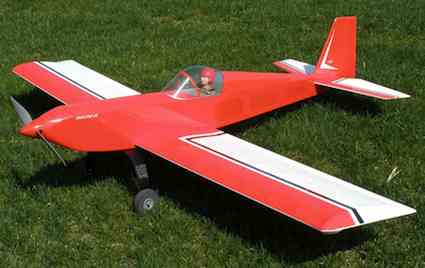
Denny Sumner photo With an APC 12x8E it is pulling about 38 amps for about 560 watts in. That is about 120 watts in per pound. The plane flies very well even though Denny is not using the motor as an equivalent power to a .46 2-stroke. March 2014 EFO Meeting The March EFO Meeting was held at Ken Myers' house on Thursday, March 20. 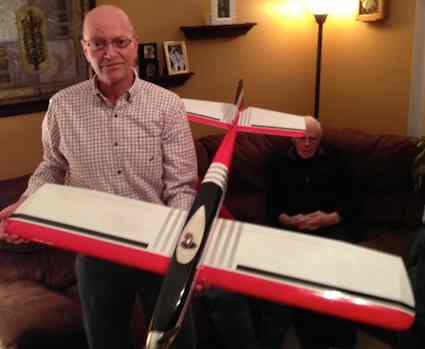 Denny Sumner shared the details of his recently completed New Era III. It was built from the Airtronics kit. The color scheme is great and it should be a great flier (is for sure - KM). 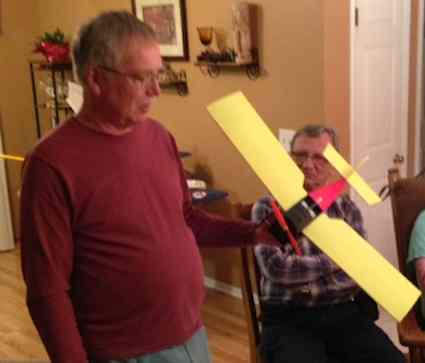 Arthur Deane brought along a fiberglass canopy that he constructed for a sailplane that heÕs working on. He described how he made, and it looks fantastic. 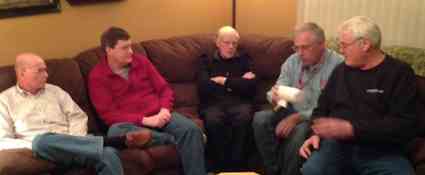 In the photo, the guys are checking out Arthur's work. 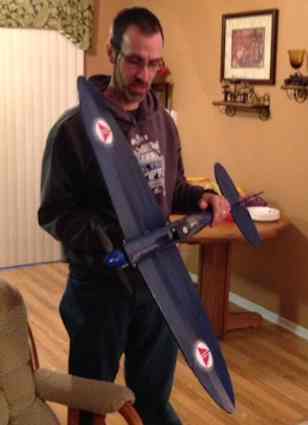 Owen Morgan brought his FliteTest.com Spitfire. It is constructed from Dollar Store foamboard and looks and flies great. 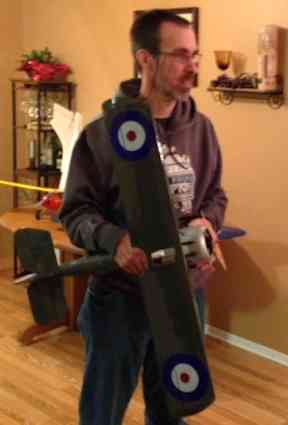 Owen told us of a very good way to find the wing area of an elliptical or other oddly shaped wing. The details will be presented in a future Ampeer. 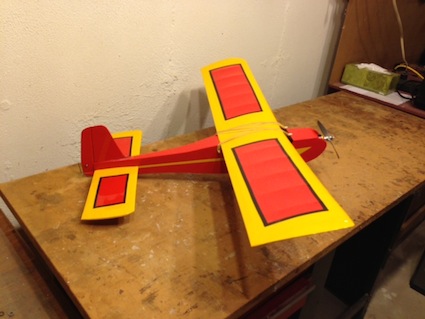
Ken's Min-E Mambo on the workbench Ken Myers shared his new Min-E Mambo, 2-channel recreation and restoration. Ken also showed and demonstrated the gliders that he had created for his Initial Center of Gravity article. April 2014 EFO Meeting The April EFO Meeting was held at Ken Myers' house on Thursday, April 24. Current projects and questions were discussed. Mike Holyroyde is getting back into doing a bit more flying. Mike is long time EFO member. He brought along a medium size Fokker D-VII that he was working on. He wants to use an Astro Flight cobalt 25 geared motor and asked about batteries to power it. LiPo and A123 type pros and cons were discussed. Ken showed Mike some A123 packs so that he might have an idea about their size and weight. Ken Myers demonstrated and shared his new flight simulator for his Mac laptop. The RC flight simulator is aerofly RC 7. Ken is using it to 'fly' while recovering from his rotator cuff surgery. He noted that he is practicing 4-point rolls, slow rolls and rolling circles. May 2014 EFO Meeting The May EFO flying meeting was held on Saturday, May 24, at the Midwest RC Society 7 Mile Rd. flying field. The weather was perfect and the turnout fantastic. Unfortunately, I was so busy instructing that I didn't remember to get any photos that day. 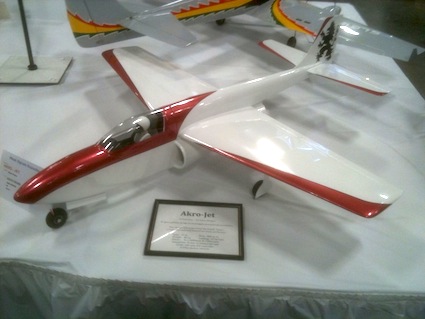
Keith Shaw's AkroJet at the Toledo Show For me, the highlight of the day was when Keith Shaw maidened both his Akro-Jet and Sausewind. They both flew wonderfully. The Akro-Jet is pure, quiet, high performance and the Sausewind a bit of nostalgic elegance in flight. 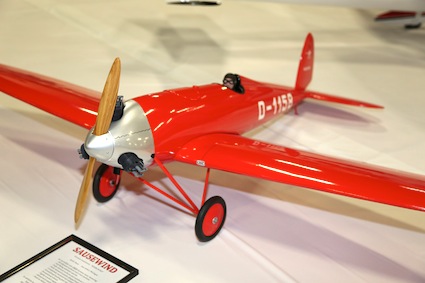
Keith Shaw's Sausewind at the Toledo Show Unfortunately, Paul Sockow's Great Planes Escapade and my Thunder Tiger Lazy Tiger Cub trainer decided to mate in midair. The outcome was not good, with both planes being destroyed. My Min-E Mambo was maidened. One the first short flight, I piloted and found it to be tail heavy. Keith verified that with a second short flight. Since the horizontal stabilizer is glued into the tail, and its incidence could not be adjusted, Keith suggested that the solution was to add a bit more nose weight. Keith also noted a slight wash-in in the right wing panel and right horizontal stabilizer. Everyone had a great time flying, talking planes and catching up. |
To Reach Ken Myers, you can land mail to the address at the top of the page. My E-mail address is: KMyersEFO@theampeer.org
